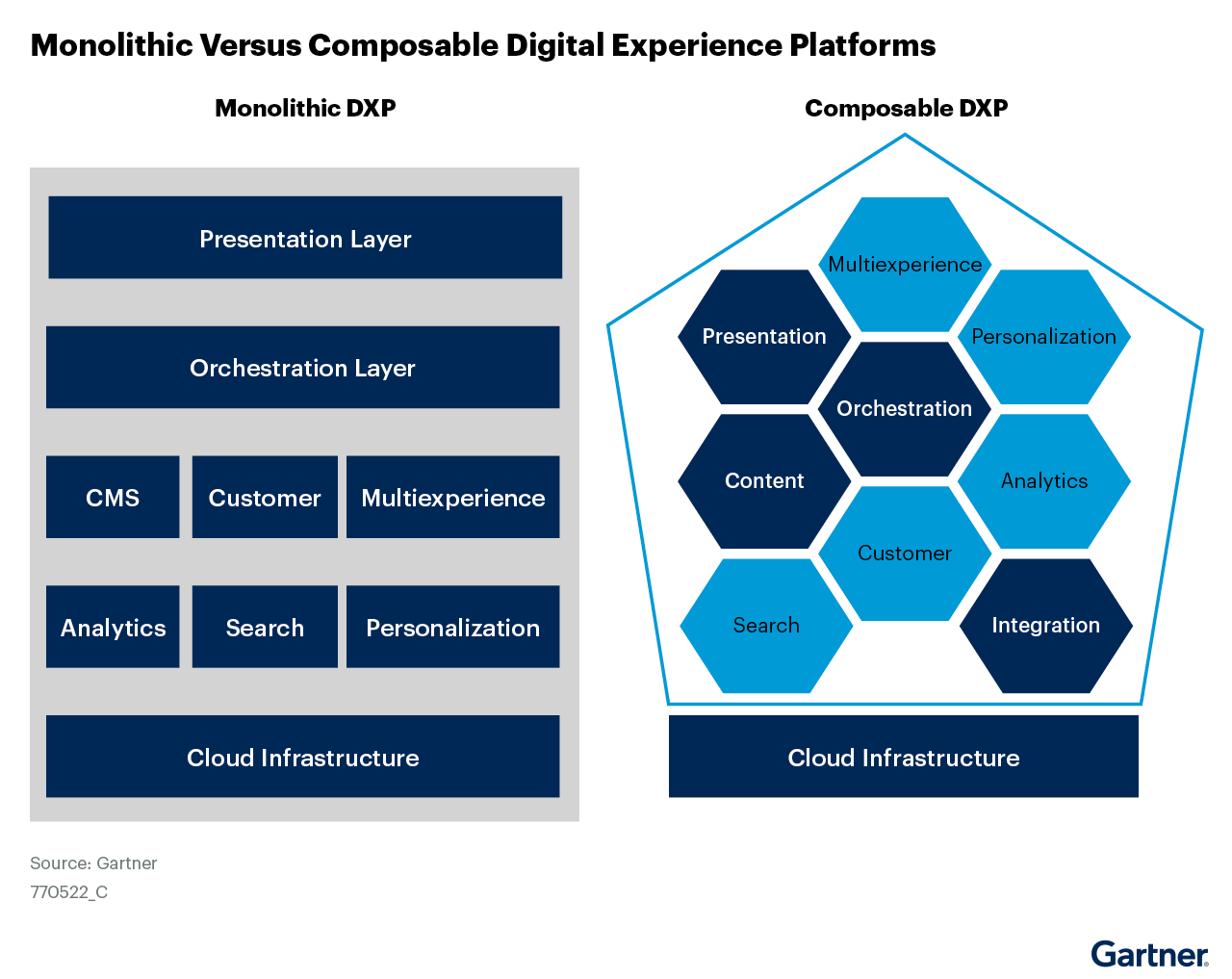Headless website architecture offers a world of possibilities for developers, but can be a pain to implement across an organization. In its 2022 Innovation Insight for Digital Experience Composition report, Gartner® defines the term Digital Experience Composition (DXC) as “an emerging market focused on digital multiexperience orchestration in an API-first, ‘headless,’ decoupled composable world.”
DXC is a solution that enables developers to have complete architectural flexibility and create amazing digital experiences, while allowing those experiences to be managed quickly and easily by marketing and businesspeople in a no-code interface.
Key Findings
In our opinion, two of Gartner's findings are of particular interest for companies:
"For organizations well-staffed with developer resources or a strong delivery partner, traditional “buy versus build” decisions have evolved into “buy and compose.” The single-vendor suite is discarded for best-of-stack/best-of-breed. Composability eases the former “build” effort as solutions are available with narrower functionality so that efforts shift to a focus on integration and optimization."
— Gartner, Innovation Insight for Digital Experience Composition, 2022
Monolithic Digital Experience Platforms (DXPs) usually offer a suite of bundled tools. This often makes it hard for sophisticated organizations to buy them as complete solutions, due to custom requirements in one or more of the tools (e.g., the personalization engine).
The decision over a headless/non-headless architecture demands a tradeoff between either compromising on some of the needed functionality in favor of being able to pick an off-the-shelf solution, or spending the resources to build an internal solution that perfectly fits the organization's needs.
In the composable world, with microservice-like architecture, organizations are empowered to find the most suitable vendor for each of their required tools — even building the pieces that are too customized to be solved by an externally built solution — and integrate them into a perfectly fitted solution.
Example: Company A uses a standard headless CMS as its marketing content source. But it also pulls data from internal databases, has its own experimentation framework, and wants to use off-the-shelf digital asset management (DAM) and product information management (PIM) systems. With a composable architecture, all those tools and data sources can be integrated together into a fully functional website.
When adding a DXC like Stackbit on top of your headless stack, you also get visual, in-context editing of all your content in the same place, regardless of its source, and for example, the ability to orchestrate a “publish” event that synchronizes for across all the separate tools. According to the Gartner report:
”Those who adopted “headless” early were forced into custom JavaScript development for their front end. Without digital experience composition, business users are unable to affect or configure the delivered experience without developer resources.”
— Gartner, Innovation Insight for Digital Experience Composition, 2022
Headless CMS are an amazing solution for separating code and content, which in turn allows each of the two to be edited independently of one another.
The problems start when the headless CMS also needs to become the editing tool for less technically-minded people, like marketers. Its form-based user interface (UI) doesn’t include a preview (hence the term "headless"), which makes for a very inconvenient tool for editing content.
This is just one of several challenges of headless CMS. For more, please read the Leader’s Guide To Overcoming Challenges with Headless CMS.
Without a DXC solution like Stackbit, headless CMS doesn’t really deliver marketers and other business stakeholders independence. They’re still forced to rely on developers to make the changes they need on the site. This slows down processes and delays changes to the website, creating bottlenecks and sparking frustration from both marketing and engineering teams.
Recommendations
As per Gartner, as an application leader responsible for CRM strategy and customer experience, you should:
“Prioritize usability and utility for business users in a no-code user interface (UI), rather than solely considering composable digital experience on a technical or architectural basis”
— Gartner, Innovation Insight for Digital Experience Composition, 2022
We believe your website should be driving the impact you need for your business, including brand awareness, leads, sales, and so forth. To accomplish that, your content-ops, marketers, and designers need to be able to make frequent changes to the website, A/B test various approaches, write blog posts, and not feel frustrated by the whole process.
Not long ago there weren't many choices:
Option 1: A decent editing UI with a limiting, wall-gardened solution
Option 2: An amazing technical solution almost inaccessible for marketers and business folks without the help of a developer or an internally built tool
You don't have to compromise anymore.
Your development team can build any custom solution they want. A DXC solution delivers absolute freedom of choice and architectural flexibility. With just one config file and no extra dependencies, you can provide a modern UI for your business stakeholders to use.
This way, each team can work efficiently on the tasks they do best (and enjoy most), producing great collaboration through independence.
In its report, Gartner states:
“Avoid a composable approach when operational simplicity is a higher priority than architectural flexibility and agility. Also avoid this approach when you lack the appropriate skills to implement custom UIs and custom integrations.”
— Gartner, Innovation Insight for Digital Experience Composition, 2022
In our opinion, this approach above was 100% correct... before Stackbit.
Stackbit delivers complete architectural flexibility and agility while maintaining operational simplicity. In short, it’s a visual editor that can easily support any technological stack.
How does it actually work?
Stackbit supports all front end frameworks and structured content sources (this includes headless CMS, but it can also be your own legacy db, an Airtable file, headless e-commerce, etc.). All it takes is one config file — no extra dependencies, no payload in production, no vendor lock-in.
This means that your marketers, content ops and businesspeople can enjoy an in-context visual editor (WYSIWYG) like a site builder, layered on top of your own custom stack without any restrictions.
Stackbit can be added to absolutely any modern website. If you don't have one, we also have robust starters, built with best practices and wired to all the popular integrations to get you going quickly. If you don't have available developers, we can also connect you with a wide variety of agencies that know how to work on modern websites, and particularly with Stackbit.
Monolithic DXPs vs Modern DXCs
By using specialized, composable technologies, IT leaders can assemble their own DXP based on the current needs of their organization. As those needs change, individual pieces can be replaced, added or removed while still maintaining a fully operational and future-proof system.

Ultimately, there is a single, most glaring problem in the purely headless approach. Developer-centric CMS means that business users, like marketing departments, don't have the right tools to edit their websites and experiences.
Gartner states:
“Monolithic DXP and commerce suites are making slow progress toward composability, but a purely headless approach lacks the user-friendly business tooling of a monolithic close-coupled suite.”
— Gartner, Innovation Insight for Digital Experience Composition, 2022
We think Stackbit is built to solve this issue by providing a contextual visual editor that works with any headless CMS or other structured content sources, including custom legacy databases, PIMs, DAMs, etc.
Whichever content sources you've chosen and whichever other tools you're integrating with (Analytics, A/B testing, etc.), your content ops, marketers, and other businesspeople will have a unified, modern user experience that doesn't require them to code or understand technical concepts and isn't replaced every few years.
There's so much more to share. If you're interested to learn more, please contact us with the form below and we can educate you on the entire ecosystem and recommend the right solution for you.
GARTNER is a registered trademark and service mark of Gartner, Inc. and/or its affiliates in the U.S. and internationally and is used herein with permission. All rights reserved.














